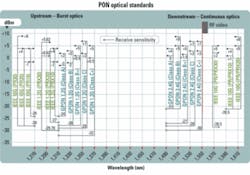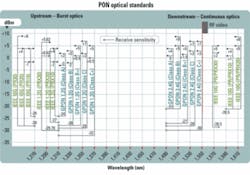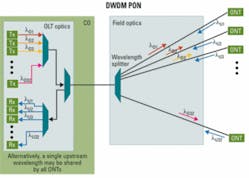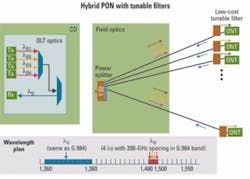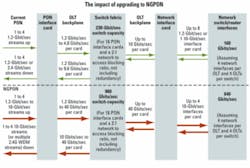by Scott Wilkinson
PONs have enjoyed widespread success for access applications for the last decade. This has been especially true over the last few years as the technology has advanced from ATM PON (APON) to broadband PON (BPON) to the two standardized flavors of Gigabit PON (GPON and GEPON).
PONs are attractive for their low outside plant (OSP) maintenance cost (no power required, no cabinet maintenance), their speed, their relative simplicity, and the fact that the OSP infrastructure — glass all of the way to the home in many cases — has nearly unlimited future potential.
While network providers and users are generally content with the bandwidth provided today, few would disagree that bandwidth demands will rise in the future. How fast those demands will increase is very difficult to predict. The rise of user-generated video, the popularity of peer-to-peer networks, and the mass acceptance of television based on Internet Protocol (IPTV) are all innovations that were generally not predicted when today's networks were designed. The definition of high-speed data is revised upward each year around the world as customers are provided 100-Mbit/sec bidirectional data in Asia, cable companies in North America announce 50-Mbit/sec tiers, and the concept of a gigabit per second to the home is demonstrated in a few select areas.
All of which begs the question, what does the next generation of PON look like and how will it take advantage of the PON infrastructure being deployed today?
The primary requirement for next-generation PON (NGPON) is that it provide significantly more bandwidth per user than is currently available. In addition, the new technology should be able to operate on the same OSP infrastructure so network providers building their access networks today will not have to build another anytime soon. The new technology should support existing services so that customers do not see a radical change in operation. And, most important, the new technology should be low cost so that it can be deployed in the millions without bankrupting the network provider.The cost of the optical network terminal (ONT) at the residence is highly sensitive and cannot rise significantly for NGPON. Some network providers would argue that NGPON ONTs must actually be less expensive than current ONTs, a requirement that can only be met through significant standardization and integration. For this reason in particular, it is very highly probable that the next successful generation of PON technologies will come from one of the two main standardization bodies for PON.
The two primary standardization bodies for PON are the IEEE and the ITU. The IEEE is responsible for GEPON (1.2 Gbits/sec bidirectional, based on Ethernet framing) and the ITU is responsible for GPON (2.4 Gbits/sec downstream/1.2 Gbits/sec upstream, based on GPON Encapsulation Method [GEM] framing). Both groups are actively developing NGPON standards.
IEEE standardization of NGPON is being developed within the 802.3 group, specifically within 802.3av. Early drafts of the standard are already in place, and many of the physical layer details are already determined. The IEEE NGPON effort is concentrating on 10G PON as the next evolution from the current 1G PON. The 802.3av standard document should be largely complete in 2009, although details will be ironed out for a few years more. Chipsets based on the early draft could appear as early as 2010. As is often the case with IEEE standards, pre-standard chipsets will be available earlier based on the preliminary work.
ITU standards typically take much longer to complete than IEEE standards but are more detailed and robust. While the ITU is the official standardization body, much of the work on NGPON that is addressed within the ITU actually takes place within Full Service Access Network (FSAN) initiative, a group of telecommunications operators and equipment manufacturers that meets regularly to develop the nuts and bolts of the standards that the ITU ratifies.
Within FSAN, there are currently two tracks working on NGPON. The first track (NGA1) is working to develop an NGPON standard that can coexist with the current GPON standard. This ìfiber leanî model assumes that operators do not have the fiber necessary to support a complete overlay network. The second, longer-term track (NGA2) has been given a blank slate to work with. Their ìfiber richî model assumes that a completely new OSP could be deployed. NGA2 is investigating options like DWDM-PON and rates up to 40 Gbits/sec.FSAN is currently developing a white paper with requirements for NGA1 and NGA2, specifications for NGA1, and initial studies for NGA2. All options are still on the table, and concepts ranging from wavelength specification to elaborate dual-mode operating ONTs are still being submitted. The white paper is expected to be completed by early 2009 for submission to the ITU, and standardization is expected to complete in late 2010 or early 2011. Chipsets based on the ITU NGPON (NGA1) standard could be available in late 2011 or 2012.
Both the ITU and the IEEE PON standardization groups are focusing on an increase in speed as the next evolution of PON, and both have agreed that 10 Gbits/sec is the next logical step up in downstream bit rate. Technical challenges for 10-Gbit/sec downstream bit rates include dispersion management, receiver sensitivity, and issues related to the higher transmit power required. Despite these challenges, all of the technologies required for 10-Gbit/sec downstream have already been demonstrated in laboratories. The remaining challenges are in commercialization and cost reduction. Figure 1 provides a summary of standards-based optical specifications.
The IEEE version of 10G PON (802.3av) has many details already in place. Three power budgets are defined (low, medium, and high) and two upstream rates (1 Gbit/sec and 10 Gbits/sec). The 1-Gbit/sec upstream rate for IEEE PON remains the same as in the current standard. For many network providers, this will not be sufficient in the long term. The 10G upstream alternative certainly provides enough bandwidth but will be too expensive for mass residential deployment in the near future.The advantage of the IEEE standard 10G PON is that it offers a relatively early transition to NGPON. If the costs of IEEE 10G PON can be made comparable to current GPON costs, IEEE 10G PON can offer a distinct advantage of up to 4� the downstream bandwidth per end user. IEEE 10G PON will also be attractive in business applications because the 10G upstream option can be implemented economically.
The ITU standard for 10G PON has fewer concrete details established than the IEEE version. While the IEEE has chosen only two upstream speed alternatives, FSAN is currently debating a third option: 2.4 Gbits/sec. This rate takes advantage of currently available GPON downstream technology and offers a reasonable intermediate rate between 1.2 Gbits/sec (too slow) and 10 Gbits/sec (too expensive).
Another option for next-generation PON is based on WDM (Fig. 2). In the generally accepted definition of WDM-PON, each end user is assigned a separate downstream wavelength, making a logical point-to-point network over a PON infrastructure. Upstream is usually a single wavelength, although separate upstream wavelengths could be supported.
When deploying WDM-PON, the power splitter used with conventional PON is replaced with a wavelength splitter. This has the advantage of keeping the received power per endpoint (ONT) much higher than with traditional PON technology. Another advantage of WDM-PON is that currently deployed GPON or GEPON ONTs can theoretically be reused. For this reason, WDM-PON is touted as a logical and low-cost upgrade for existing PONs.The major argument against WDM-PON is that the costs are much higher overall due to the large number of transmitters required. While a conventional PON deployment requires only one transmitter per 32 or 64 ONTs, WDM-PON requires a separate transmitter for each ONT. This raises the cost not only of the equipment but of the power and space required as well.
Proponents of WDM-PON are working to mitigate its limitations, but in general the technology has not been successful outside of proprietary deployments in Korea. In general WDM-PON is not currently being seriously studied by either PON standards body. FSANÃs NGA2 track still has WDM-PON as an option for study and may revisit the technology in the future.
With fully standards-based 10G PON still several years away, what is a network provider who is running out of bandwidth to do in the interim?
An innovative idea that has been proposed by some vendors is a hybrid WDM approach (see Fig. 3). Basic hybrid WDM-PON uses standard GPON, but four different wavelengths are sent downstream simultaneously. The four wavelengths are all within the ONT receiversà wavelength window, so the ONTs do not have to be changed out. Each end user has now been moved from a 1:32 physical OSP to a 1:8 logical OSP.
A second variant of the hybrid WDM approach places tunable filters at the ONT (see Fig. 4). This approach is more flexible, as the allocation of the four wavelengths can be dynamically reassigned. However, the addition of the tunable filter at each ONT makes this approach much more expensive in both capital and operational costs.
The primary argument against hybrid WDM-PON is the limited upstream bandwidth. While downstream bandwidth is increased fourfold, upstream bandwidth is not increased at all. For network operators who believe that their network demands will be highly asymmetrical for the near future, hybrid WDM could be an attractive evolutionary technology. However, as traffic patterns continue to become more symmetrical and customers demand more upstream bandwidth, hybrid WDM eventually should be phased out in favor of true NGPON.
Other interim steps include reach extension to increase the range of PON and serve more customers from the same central location, higher split ratios to reduce overall per-user cost, and integrated optical switches to improve maintenance complexity and reliability of PONs. All of these innovations capitalize on the phenomenal success of PON as an access network option and serve to extend the life of current PONs until NGPON is mature.
NGPON technologies, in particular 10G PON, are coming quickly, but standards are still a few years away. Multiple options are available, and standards bodies are working hard to narrow them down to a workable few. However, even once those standards have been finalized additional challenges will delay the widespread commercial availability of NGPON.A critical fact to consider is that the advances being discussed in standards bodies will result in significantly higher bandwidth requirements behind the PON interface. An upgrade from 1.2 Gbits/sec or 2.4 Gbits/sec downstream to 10 Gbits/sec downstream will require a proportional upgrade in the backplane, switch fabric, and network interfaces on the OLT, not to mention upgrades to all of the network infrastructure behind the OLT. While all of these technologies are available in some form, they are significantly more expensive and power-hungry than the currently deployed equipment. This means that NGPON equipment based on currently available technology would be much larger, much less dense, and require much more power than existing PON equipment.
Combine these realities with the continued pressure from operators for higher density shelves to reduce footprint costs and the pressure for ìgreenî approaches that use less power, and there are significant challenges to be met before NGPON is deployed widely. Figure 5 summarizes the impact of upgrading to NGPON.
Current GPON and GEPON infrastructure offers ample bandwidth for most networks, and innovative interim steps are being proposed to extend the life of these technologies. Ultimately, there should be no penalty to deploying todayÃs technology, as the next-generation upgrades should adapt nicely. When customer demand for bandwidth inevitably reaches beyond the capabilities of todayÃs networks, tomorrowÃs technology will be ready to support it.
Scott Wilkinson, PhD, is vice president of product management and system engineering at Hitachi Telecom USA (www.hitachitelecom.com).
